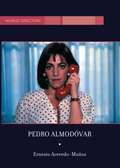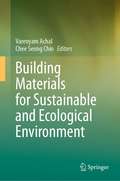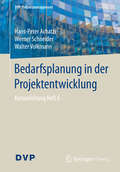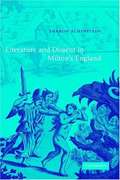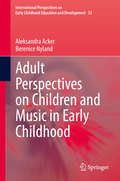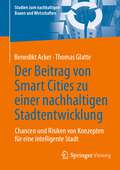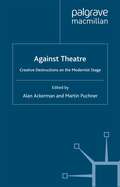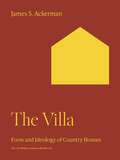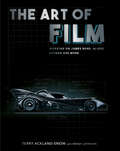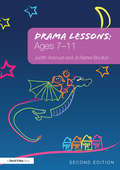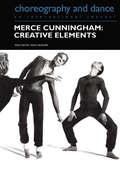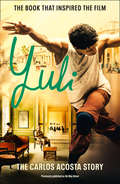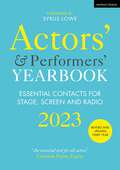- Table View
- List View
Pedro Almodovar (World Directors)
by Ernesto R. Acevedo-MunozThe book provides a detailed introduction to the essential themes, style, and aesthetics of Pedro Almodovar's films, put in the context of Spain's profound cultural transitions since 1980. With precise and close analysis, the book covers the major concerns of the most successful of all Spanish film directors and makes direct, clear connections to the logic of Almodovar's aesthetic and stylistic choices. By spanning the entirety of Pedro Almodovar's feature making career, the book emphasizes the director's sensibility to make the outrageous believable and to always give a unique spin to the issues Spanish history, culture and identity. A detailed and comprehensive approach to all of Pedro Almodovar's feature films from the outrageous 1980 'Pepi, Luci, Bom and Other Girls on the Heap' to the sophisticated 2004 'Bad Education', this book provides more than an introduction an intimate look at the topics, style, aesthetics and cultural sensibilities of Spain's most distinguished and celebrated film director since Luis Bunuel. By focusing on a film-by-film, and often scene-by-scene analysis, this book offers a meticulous interpretation of characters, situations, allusions and cultural intersections, as well as emphasizing the meaning and weight of cultural, historical and social contexts. The book traces the evolution of Almodovar's career, from the perspective of aesthetic, narrative and stylistic concerns and places those changes in the logical context of Spain's historical trajectory from the end of Franco's dictatorship to the transition to democracy, exploring Almodovar's interest on issues of identity, sexuality, and nationalism.
Building Materials for Sustainable and Ecological Environment
by Varenyam Achal Chee Seong ChinThis book uses theories, hypotheses, policies, practical insights and case studies to introduce and elucidate green building materials for sustainable construction. Cement is the most widely used building material in construction; however, it is not sustainable, being responsible for 7% of global carbon dioxide emissions and consuming huge quantities of energy. In order to limit the ecological damage, sustainable building materials are needed. Ecosystems are a source of important lessons and models for transitioning the built environment onto a sustainable path that opens options for sustainable building material in construction. The book provides a guide for readers seeking knowledge on sustainable building materials with the potential to lower environmental impact by reducing CO2 emission throughout the building’s lifecycle. The book is motivated by recent rapid advances in sustainable building materials production, including green building materials made of industrial by-products and recycled wastes, earth materials, plant-based materials, microbial-based materials or supplementary cementitious materials, to reduce the environmental impacts of traditional building materials. Discussing the development and applications of various sustainable building materials, including related case studies, and addressing the environmental issue with a holistic and systematic approach that creates an ecology of construction for sustainability in infrastructures, it offers promising solutions to achieve renewable and sustainable building materials for the future.
Bedarfsplanung in der Projektentwicklung: Kurzanleitung Heft 6 (DVP Projektmanagement)
by Hans-Peter Achatzi Werner Schneider Walter VolkmannDas Buch ist ein kompakter Leitfaden zur schrittweisen Erarbeitung der Bedarfsplanung von Hochbauaufgaben. Großprojekte stehen durch Budget- und Terminüberschreitungen zu Recht in der Kritik der Öffentlichkeit. Doch sie sind nur die Spitze des Eisbergs. Auch bei weniger spektakulären Projekten werden Ziele immer wieder verfehlt. Oft werden sie teurer, später fertig und erreichen nicht die erwartete Qualität. Die Fachwelt ist sich einig, dass die entscheidenden Fehler in der ersten Phase eines Projektes gemacht werden, und zwar in der Erarbeitung und Abstimmung der qualitativen und quantitativen Anforderungen. Auch die vom Bundesministerium für Verkehr und digitale Infrastruktur einberufene „Reformkommission Bau von Großprojekten“ hebt die Bedeutung der ersten Schritte in einem Bauprojekt hervor.
The Future of Clothing: Will We Wear Suits on Mars?
by Simone Achermann Stephan SigristDisappearing dress codes, customers as designers and wearable technology; in recent years the production and function of clothing has undergone massive change. New manufacturing technologies have brought bespoke design within reach of many consumers for the first time. Miniature sensors can turn ordinary garments into smart devices. And blurring gender roles and class distinctions point the way towards a more fluid approach to clothing, fashion and design. The Future of Clothing offers a critical introduction to these developments from an interdisciplinary perspective, engaging with their implications for the clothing industry and related fields. You'll learn how mass-personalization impacts the luxury market, the effects of automation on craftsmanship and how AI design may affect individual style choices.Contributors include fashion historian, author and broadcaster Amber Butchart, adventurer, ecologist and head of the Sculpt the Future Foundation David de Rothschild, and best-selling author Yuval Noah Harari. There are also 8 exclusive illustrations by Salvador Dali, depicting the surrealist master's extraordinary vision of how fine-tailored clothing might evolve in the 21st century. Together they form a truly unique guide to the future of this most creative industry.
The Future of Clothing: Will We Wear Suits on Mars?
by Simone Achermann Stephan SigristDisappearing dress codes, customers as designers and wearable technology; in recent years the production and function of clothing has undergone massive change. New manufacturing technologies have brought bespoke design within reach of many consumers for the first time. Miniature sensors can turn ordinary garments into smart devices. And blurring gender roles and class distinctions point the way towards a more fluid approach to clothing, fashion and design. The Future of Clothing offers a critical introduction to these developments from an interdisciplinary perspective, engaging with their implications for the clothing industry and related fields. You'll learn how mass-personalization impacts the luxury market, the effects of automation on craftsmanship and how AI design may affect individual style choices.Contributors include fashion historian, author and broadcaster Amber Butchart, adventurer, ecologist and head of the Sculpt the Future Foundation David de Rothschild, and best-selling author Yuval Noah Harari. There are also 8 exclusive illustrations by Salvador Dali, depicting the surrealist master's extraordinary vision of how fine-tailored clothing might evolve in the 21st century. Together they form a truly unique guide to the future of this most creative industry.
Experimental Museology: Institutions, Representations, Users
by Marianne AchiamExperimental Museology scrutinizes innovative endeavours to transform museum interactions with the world. Analysing cutting-edge cases from around the globe, the volume demonstrates how museums can design, apply and assess new modes of audience engagement and participation. Written by an interdisciplinary group of researchers and research-led professionals, the book argues that museum transformations must be focused on conceptualizing and documenting the everyday challenges and choices facing museums, especially in relation to wider social, political and economic ramifications. In order to illuminate the complexity of these challenges, the volume is structured into three related key dimensions of museum practice - namely institutions, representations and users. Each chapter is based on a curatorial design proposed and performed in collaboration between university-based academics and a museum. Taken together, the chapters provide insights into a diversity of geographical contexts, fields and museums, thus building a comprehensive and reflexive repository of design practices and formative experiments that can help strengthen future museum research and design. Experimental Museology will be of great value to academics and students in the fields of museum, gallery and heritage studies, as well as architecture, design, communication and cultural studies. It will also be of interest to museum professionals and anyone else who is interested in learning more about experimentation and design as resources in museums.
Experimental Museology: Institutions, Representations, Users
by Marianne Achiam Michael Haldrup Kirsten DrotnerExperimental Museology scrutinizes innovative endeavours to transform museum interactions with the world. Analysing cutting-edge cases from around the globe, the volume demonstrates how museums can design, apply and assess new modes of audience engagement and participation. Written by an interdisciplinary group of researchers and research-led professionals, the book argues that museum transformations must be focused on conceptualizing and documenting the everyday challenges and choices facing museums, especially in relation to wider social, political and economic ramifications. In order to illuminate the complexity of these challenges, the volume is structured into three related key dimensions of museum practice - namely institutions, representations and users. Each chapter is based on a curatorial design proposed and performed in collaboration between university-based academics and a museum. Taken together, the chapters provide insights into a diversity of geographical contexts, fields and museums, thus building a comprehensive and reflexive repository of design practices and formative experiments that can help strengthen future museum research and design. Experimental Museology will be of great value to academics and students in the fields of museum, gallery and heritage studies, as well as architecture, design, communication and cultural studies. It will also be of interest to museum professionals and anyone else who is interested in learning more about experimentation and design as resources in museums.
The Chicago School of Architecture: Building the Modern City, 1880–1910 (Shire Library USA #741)
by Rolf AchillesThe birth of the skyscraper in Chicago in the mid-1880s introduced a new direction for city architecture: upwards. But how-and why- was it that Chicago set the standard for high-rise buildings, not only across the USA but all over the world? Rolf Achilles here introduces the style of the First Chicago School from 1880 to 1910, explaining the innovative use of iron frames for strength, height and openness, and the ubiquity of gridded window arrangements. With reference to such famous architects as William Le Baron Jenny and Frank Lloyd Wright, and colorful pictures of, among many others, the Reliance, Brooks and Marquette buildings, this book is a fascinating exploration of the structures that helped to give Chicago its identity, and the world a new way of building.
The Chicago School of Architecture: Building the Modern City, 1880–1910 (Shire Library USA)
by Rolf AchillesThe birth of the skyscraper in Chicago in the mid-1880s introduced a new direction for city architecture: upwards. But how-and why- was it that Chicago set the standard for high-rise buildings, not only across the USA but all over the world? Rolf Achilles here introduces the style of the First Chicago School from 1880 to 1910, explaining the innovative use of iron frames for strength, height and openness, and the ubiquity of gridded window arrangements. With reference to such famous architects as William Le Baron Jenny and Frank Lloyd Wright, and colorful pictures of, among many others, the Reliance, Brooks and Marquette buildings, this book is a fascinating exploration of the structures that helped to give Chicago its identity, and the world a new way of building.
Literature And Dissent In Milton's England (PDF)
by Sharon AchinsteinThe England of John Milton's great poems was the England of Dissenters, those who refused to join the state Church after the return of monarchy in 1660, seen as dangerous outcasts and rebels. Sharon Achinstein's book shows how a literary tradition of dissent was produced by those who suffered political defeat and religious exclusion in Restoration England, bringing to view a range of writing that has been largely, and unjustly, neglected. Considering authors both inside and outside the dissenting tradition, including Milton, John Bunyan, Richard Baxter, Mary Mollineux, John Dryden, Andrew Marvell, Elizabeth Singer Rowe and Isaac Watts, and other little-known dissenting writers, Achinstein shows how a distinctive Dissenting cultural legacy challenges our notions of literary history, aesthetic value and the relation between literature and politics. This important study will be of interest to Milton scholars and seventeenth-century literary and religious historians.
Adult Perspectives on Children and Music in Early Childhood (International Perspectives on Early Childhood Education and Development #33)
by Aleksandra Acker Berenice NylandThis book focuses on the importance and role of adults in promoting music in the early years. Designed to promote the idea of the value of music in the early childhood years, the research discussed in this book explores the experiences of a number of adults working with children from birth to age 8. The initiatives discussed in this work all focus on adults who have encouraged the development of musical identities ranging from music in the home, to musical play in the preschool years, preparing a performance with children, and programs for disadvantaged groups that use music as a communicative tool. Each chapter will start with a description of the particular setting and the protagonists’ specific skills and interests and how they came to be working with young children. Themes for the chapters have emerged from the videos and interviews conducted and consist of both reflective and affective experience. The themes include musical background, the adults' own stories, theories of childhood, and pedagogy and philosophy.
Der Beitrag von Smart Cities zu einer nachhaltigen Stadtentwicklung: Chancen und Risiken von Konzepten für eine intelligente Stadt (Studien zum nachhaltigen Bauen und Wirtschaften)
by Benedikt Acker Thomas GlatteDieses Fachbuch vermittelt einen umfassenden Überblick über den Beitrag, welchen eine Smart City zu einer nachhaltigen Stadtentwicklung leisten kann. Unter Bezugnahme aktuell präsenter Megatrends erfolgt eine systematische Einordnung der Rolle der Immobilienwirtschaft im umfassenden Konstrukt einer intelligenten Stadt. Mittels Analysen vielversprechender Konzepte im Bereich der Smart City wird dabei der zusätzliche Mehrwert herausgearbeitet, welcher im Kontext der Nachhaltigkeit bei der Modernisierung und Revitalisierung von Gebäuden und Quartieren entstehen kann.
Architecture and Ugliness: Anti-Aesthetics and the Ugly in Postmodern Architecture
by Wouter Van Acker Thomas MicalWhatever 'ugliness' is, it remains a problematic category in architectural aesthetics - alternately vilified and appropriated, either to shock or to invert conventions of architecture.This book presents eighteen new essays which rethink ugliness in architecture - from brutalism to eclectic postmodern architectural productions - and together offer a diverse reappraisal of the history and theory of postmodern architecture and design. The essays address both broad theoretical questions on ugliness and postmodern aesthetics, as well as more specific analyses of significant architectural examples dating from the last decades of the twentieth century, addressing the relation between the aesthetic register of ugliness and aesthetic concepts such as brutalism, kitsch, the formless, ad hoc-ism, the monstrous, or the grotesque.The aim of this volume is not simply to document the history of a postmodern anti-aesthetic through case studies. Instead, it aims to shed light on an aesthetic problem that has been largely overlooked in the agenda of architectural theory, the question if and how ugliness can be of interest to architecture; or if and how architecture can make good use of ugliness.
Architecture and Ugliness: Anti-Aesthetics and the Ugly in Postmodern Architecture
by Wouter Van Acker Thomas MicalWhatever 'ugliness' is, it remains a problematic category in architectural aesthetics - alternately vilified and appropriated, either to shock or to invert conventions of architecture.This book presents eighteen new essays which rethink ugliness in architecture - from brutalism to eclectic postmodern architectural productions - and together offer a diverse reappraisal of the history and theory of postmodern architecture and design. The essays address both broad theoretical questions on ugliness and postmodern aesthetics, as well as more specific analyses of significant architectural examples dating from the last decades of the twentieth century, addressing the relation between the aesthetic register of ugliness and aesthetic concepts such as brutalism, kitsch, the formless, ad hoc-ism, the monstrous, or the grotesque.The aim of this volume is not simply to document the history of a postmodern anti-aesthetic through case studies. Instead, it aims to shed light on an aesthetic problem that has been largely overlooked in the agenda of architectural theory, the question if and how ugliness can be of interest to architecture; or if and how architecture can make good use of ugliness.
Against Theatre: Creative Destructions on the Modernist Stage (Performance Interventions)
by A. Ackerman M. PuchnerAgainst Theatre shows that the most prominent writers of modern drama shared a radical rejection of the theatre as they knew it. Together with designers, composers and film makers, they plotted to destroy all existing theatres. But from their destruction emerged the most astonishing innovations of modernist theatre.
Palladio (Architecture And Society Ser.)
by James Ackerman Phyllis MassarPalladio (1508-80) combined classical restraint with constant inventiveness. In this study, Professor Ackerman sets Palladio in the context of his age - the Humanist era of Michelangelo and Raphael, Titian and Veronese - and examines each of the villas, churches and palaces in turn and tries to penetrate to the heart of the Palladian miracle. Palladio's theoretical writings are important and illuminating, he suggests, yet they never do justice to the intense intuitive skills of "a magician of light and colour". Indeed, as the photographs in this book reveal, Palladio was "as sensual, as skilled in visual alchemy as any Venetian painter of his time", and his countless imitators have usually captured the details, but not the essence of his style. There are buildings all the way from Philadelphia to Leningrad which bear witness to Palladio's "permanent place in the making of architecture", yet he also deserves to be seen on his own terms.
The Architecture of Michelangelo (Pelican Bks.)
by James S. AckermanIn this widely acclaimed work, James Ackerman considers in detail the buildings designed by Michelangelo in Florence and Rome—including the Medici Chapel, the Farnese Palace, the Basilica of St. Peter, and the Capitoline Hill. He then turns to an examination of the artist's architectural drawings, theory, and practice. As Ackerman points out, Michelangelo worked on many projects started or completed by other architects. Consequently this study provides insights into the achievements of the whole profession during the sixteenth century. The text is supplemented with 140 black-and-white illustrations and is followed by a scholarly catalog of Michelangelo's buildings that discusses chronology, authorship, and condition. For this second edition, Ackerman has made extensive revisions in the catalog to encompass new material that has been published on the subject since 1970.
The Villa: Form and Ideology of Country Houses (The A. W. Mellon Lectures in the Fine Arts #34)
by James S. AckermanA classic account of the villa—from ancient Rome to the twentieth century—by “the preeminent American scholar of Italian Renaissance architecture” (Architect’s Newspaper)In The Villa, James Ackerman explores villa building in the West from ancient Rome to twentieth-century France and America. In this wide-ranging book, he illuminates such topics as the early villas of the Medici, the rise of the Palladian villa in England, and the modern villas of Frank Lloyd Wright and Le Corbusier. Ackerman uses the phenomenon of the “country place” as a focus for examining the relationships between urban and rural life, between building and the natural environment, and between architectural design and social, cultural, economic, and political forces. “The villa,” he reminds us, “accommodates a fantasy which is impervious to reality.” As city dwellers idealized country life, the villa, unlike the farmhouse, became associated with pleasure and asserted its modernity and status as a product of the architect’s imagination.
The Art of Film: Working on James Bond, Aliens, Batman and More
by Terry Ackland-SnowThere is no substitute for experience. I’ve had the privilege and honour to have worked alongside Terry Ackland-Snow for many years. Not only is he a prince among men and a close friend, he is also the design equivalent of Lionel Messi when it comes to creating a world and an environment for actors to do our stuff. TRobson Green ‘Tim Burton came in and commented, “Great, but how do they get in the car? There aren’t any doors!” Sadly, I hadn’t thought of that.’ What do On Her Majesty’s Secret Service, 2001: A Space Odyssey and The Great Muppet Caper have in common? Terry Ackland-Snow worked on them, that’s what. In The Art of Film, Terry lifts the lid on his extraordinary career, from being held hostage by a wannabe film crew in Jamaica to forgetting to add doors to the Batmobile. It is an insight into a lifetime of working in the film industry, mixing the amusing anecdotes with revelations about just how the magic in these movies was created. With over 200 images, including set sketches and design plans, this is a book no film aficionado should be without!
Drama Lessons: Ages 7-11
by Judith Ackroyd Jo Barter-BoultonDrama Lessons: Ages 7–11 offers an exciting and varied range of tried and tested lessons tailor-made for busy teachers. Drama Lessons: Ages 7–11 emerges from the continuing positive responses to Drama Lessons for Five to Eleven Year Olds (2001). In this book you will find a carefully chosen selection of the best lessons from the original book, plus some exciting new material – a combination of brand new and classic lessons. This new collection introduces Literacy Alerts which identify how the drama activities develop aspects of literacy and suggest additional literacy activities. For each lesson plan, essential resources and timing information are provided. The lessons cover a range of themes and curriculum areas. Full of pick-up-and-go lesson plans, this book will be of enormous interest to specialists and non-specialists of drama alike. All primary teachers, literacy coordinators and teaching assistants should have this book in their hands and it will give all trainee teachers a flying start in their school placements.
Drama Lessons: Ages 7-11
by Judith Ackroyd Jo Barter-BoultonDrama Lessons: Ages 7–11 offers an exciting and varied range of tried and tested lessons tailor-made for busy teachers. Drama Lessons: Ages 7–11 emerges from the continuing positive responses to Drama Lessons for Five to Eleven Year Olds (2001). In this book you will find a carefully chosen selection of the best lessons from the original book, plus some exciting new material – a combination of brand new and classic lessons. This new collection introduces Literacy Alerts which identify how the drama activities develop aspects of literacy and suggest additional literacy activities. For each lesson plan, essential resources and timing information are provided. The lessons cover a range of themes and curriculum areas. Full of pick-up-and-go lesson plans, this book will be of enormous interest to specialists and non-specialists of drama alike. All primary teachers, literacy coordinators and teaching assistants should have this book in their hands and it will give all trainee teachers a flying start in their school placements.
Child Actors on the London Stage, Circa 1600: Their Education, Recruitment and Theatrical Success
by Julie AckroydA legal document dated 1600, for a Star Chamber case titled Clifton versus Robinson, details how boys were abducted from London streets and forcibly held in order to train them as actors for the Blackfriars theatre. No adults were seen on-stage in this theatre, which was stocked solely by acting boys, resulting in a satirical and scurrilous method of play presentation. Were the boys specifically targeted for skills they may have possessed which would have been applicable to this type of play presentation? And, was this method of recruitment typical or atypical of Elizabethan theatre? Analysis of the background of the boy subjects of the legal case indicate that several had received grammar-school tuition and, as a result, would have possessed skills in oration and rhetoric. Indeed, a significant number of the grammar schools in London provided regular public disputations and theatrical performances which would have made these boys an attractive proposition for inclusion in a theatrical company. The styles of play-texts which the boys performed and their manner of presenting characters helps to assess why child acting companies were commercially viable and popular. Their portrayal of all roles in a performance; young and old, male and female, clearly demonstrated their versatility and skill in mimicry and the adoption of other personas. Therefore the taking of grammar-school boys for re-training as actors was not opportunistic; their abductions were planned. The theatre owners undertook this method of recruitment as they felt that they were immune from prosecution due to holding royal commissions which they used to recruit boys. However, the Clifton vs. Robinson case clearly demonstrates that a determined parent whose child had been taken could challenge this and demand reparation.
Merce Cunningham: Creative Elements (Choreography and Dance Studies Series #Vols. 4, Pts. 2.)
by Joan Acocella Elliot Caplan Marilyn Vaughan Drown William Fetterman John Holzaepfel Gordon Mumma Nelson Rivera Thecla Schiphorst David VaughanMerce Cunningham reached the age of 75 in 1994, an age at which many creative artists are content to rest on their laurels, or at least to leave behind whatever controversies they may have caused during their careers. No so Cunningham. In the first place, his 70s have been a time of intense creativity in which he has choreographed as many as four new works a year. Cunningham is a strongly committed as ever to the discovery of new ways of moving and of making movement, refusing to be hampered by the physical limitations that have come with age. Since 1991 every new work has been made at least in part with the use of the computer program Life Forms, which enables him to devise choreographic phrases that he himself would be unable to perform - and which challenge and develop the virtuosity of the young dancers in his company.The essays collected in this special issue of Choreography and Dance were written over the last few years and discuss various aspects of the work of Cunningham as seen both from the outside and the inside.
Yuli: A Cuban Dancerâs Story
by Carlos AcostaNOW AN AWARD-WINNING FEATURE FILM STARRING CARLOS ACOSTA
Actors' and Performers' Yearbook 2023
by Actors' and Performers' Yearbook Foreword by Syrus LoweThis well-established and respected directory supports actors in their training and search for work in theatre, film, TV, radio and comedy.It is the only directory to provide detailed information for each listing and specific advice on how to approach companies and individuals, saving hours of further research. From agents and casting directors to producing theatres, showreel companies, photographers and much more, this essential reference book editorially selects only the most relevant and reputable contacts for the industry.Covering training and working in theatre, film, radio, TV and comedy, it contains invaluable resources such as a casting calendar and articles on a range of topics from your social media profile to what drama schools are looking for to financial and tax issues.With the listings updated every year, the Actors' and Performers' Yearbook continues to be the go-to guide for help with auditions, interviews and securing/sustaining work within the industry. An invaluable professional tool that anyone working in the industry will benefit from.Actors' and Performers' Yearbook 2023 is fully updated and features a new foreword by Syrus Lowe.
